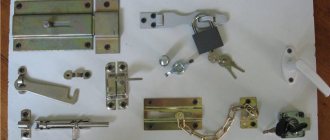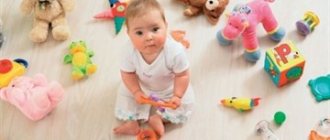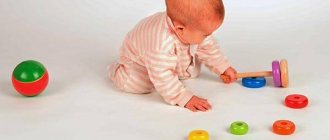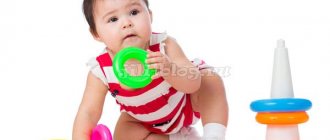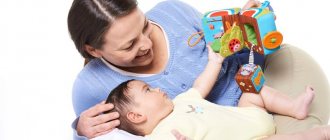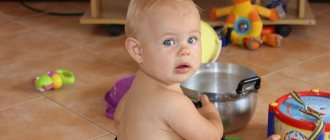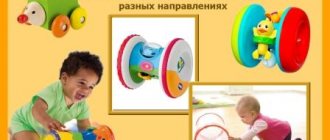Skills you already have
At 8 months, babies babble almost non-stop. They try to imitate the language of adults. At the same time, they already understand what the adult wants from them and can fulfill his basic requests. For example, give your hand and show where the toy is. Eight-month-old babies understand the difference between relatives and strangers. They rejoice when they see the former and are frightened by the latter. And parting with their mother is generally very difficult for them. Babies may cry, be fussy, and constantly reach out to their mother.
Children already sit quietly and know how to sit down from different positions. Some can stand up, leaning on something, or even take their first steps, holding on to the support. A child at this age crawls very actively. However, each baby does this differently. Some people need to push off with their heels, others with their knees, and others need to move back a little. Perhaps this is due to how the baby managed to do this for the first time.
In everyday life, the baby also becomes more skillful. He can pick up a mug, eat from a spoon and go potty. If your baby doesn’t know how to do this yet or is very bad at these actions, don’t be upset. He will definitely succeed, he just needs more time. He can be helped to develop all these skills through games.
What educational toys are needed from 4 to 6 months?
At this time, the baby begins to move: sits down, stretches up. Therefore, there are also more toys, and the space for games itself grows to the size of a playpen, a bed, or a carpet in a nursery. Now you can add soft ones to plastic and rubber toys - if they are easy to wash; more toys that make sounds and move: tumblers, bells, squeaking balls. This is how the child learns to distinguish objects by touch and form an impression of them, observe things in motion and react correctly - repeat, pursue or evade. Toys during this period should be such that the baby moves a lot, but consciously, developing coordination and motor skills.
Games for physical development
Any child’s skill can be very easily developed through play. Please note that at 8 months a child perceives almost everything as a game. You just need to add a little cheerfulness to everyday activities and smile more, then the baby will be happy to learn everything. Almost all games with an 8-month-old baby are aimed at physical development.
Each educational game for children 8 months old should be repeated daily, possibly several times.
Crawl
Place something soft on the floor. For example, a blanket or rug. Check that there are no folds anywhere. Next, place children's toys on it in different places. The child will crawl from one toy to another. Sometimes from fatigue he can fall asleep right there. Don't disturb him. In order for the baby to crawl more actively, call him to you. And when he crawls, be sure to praise him. He will be very happy about this. Remember that the most important thing in a child’s development is communication.
Catch-up
This game requires maximum adult participation. He should crawl with the child, catching up with him and thereby stimulating him to crawl faster. As soon as the adult has caught up with the baby, he must praise him and hug him.
Obstacles
Make an “obstacle course” for your baby: use pillows to create a mountain, large boxes for a tunnel, a blanket for a cave. Thanks to crawling over such obstacles, the baby will study the relationship between the sizes of objects, distances and its position in space.
Lifting training
For this game, equip yourself with a highchair. Its back must be tilted so that the baby can grab onto it. Next, begin to lightly pull the chair towards you. The baby will gradually begin to stand up: first on his knees, then completely. Watch his feet carefully: they should be pressed to the floor. If he doesn’t know how to stand like that yet, then press them with your hand.
First steps
Invite your baby to grab onto your fingers. When it holds fairly tightly, gradually begin to lift it. Be sure to praise the baby. When he stands still for a while, pull him towards you so that he tries to take his first steps. Do this exercise on something soft so that if you land hard, your baby won’t hit himself. And be sure to smile so that he is sure that he is playing with you.
Ability to step over
All children walk at first, only holding on to something. When the child is standing and holding on to support, call him to you. Let him try to step with his feet and grab with his hands. Praise him for every step he takes. If he doesn't want to take more than one step, praise him and repeat the exercise later.
Educational games
Story-based games with children at 9 months will help develop a kind attitude towards the world around them. The simplest games are with a story toy, when she dances, eats, jumps on the sofa, and goes to bed. During the fun, be sure to tell what the toy does.
During the game, it is important to demonstrate an emotional attitude towards a doll or soft toy: praise, pity
Make a flatbread of dough and stick beans, curly pasta, nuts, and pebbles into it. The child will be happy to pick them out. Offer to put nuts in a basket, toothpicks in a box. All these fun activities develop fine motor skills. Finger games develop hand motor skills and also help improve speech.
Object manipulation
Activities can be carried out with your child by playing with spoons, cooking spatulas, pots and plastic containers. Allow your child to rustle through the bags and unwind a roll of toilet paper. Take a container and put bright objects. Then take them out one by one and show the empty container, saying: “Empty, there is nothing.”
Child intelligence development
For children 9 months old, educational games should be aimed at improving speech. Do the following exercises:
- cluck like a horse;
- smack as if kissing;
- puff out your cheeks and hit them with your hands, imitating a burst bubble.
Teach children to say syllables. Teach your child to distinguish relatives from each other.
Mastering cause-and-effect relationships
You can help your child identify the cause-and-effect relationships of what is happening through auditory associations. Hang bells with different sounds near the doors of each room. Walk with your child, opening and closing doors. In each case the bell will ring differently. The little explorer will understand when you entered the kitchen or nursery. For the development of a child at 9 months, the game “Ladushki” is useful, which develops coordination of movements.
Sensory development
Sensory sensations are also needed by a baby at 8 months for development. Therefore, do not forget to pay attention to them in daily games with your baby. They don't take much time, and some of them can be done even during everyday activities.
Entertainment while walking
It is very important for a child to experience the world through taste, tactile and visual senses. Let him touch sand, leaves, branches, oxen, pebbles or snow during your walks. He will learn to distinguish different structures and sizes of things. He could just ride in a stroller before.
Toys from scrap materials
If you have jars with twist-off lids, they will be a great game for your baby. And if you also have them of different sizes, then great. Give them to your baby. Let him try to open and close them, and put his toys in there. This game also helps children develop the relationship between things of different sizes. It is very important for them that you accompany all their actions with comments, praise and tips.
Sensory treasure
From scraps you can build an amazing “Sensory Treasure” for your little one. That is, put objects with different characteristics into one box. For example, in your box you can put some kind of fur product, a pebble, a toy that squeaks, a twig, a nesting doll, several bells and a mirror. Just make sure the baby doesn't get hurt. The essence of the game is that you take out objects one by one, give them to the baby, show them and talk about them. In this way, the child will become familiar with various objects and their characteristics.
Remember to ensure that small parts of toys do not get into your baby’s mouth.
Musical games and singing
Developmental activities with the baby must include musical games and singing. Just turn on music for your baby or buy toys that make melodies. For example, your baby will definitely enjoy playing with a drum, metallophone or tambourine. Your task is to show him how these instruments work and play them together. When choosing a toy, be sure to listen to it.
Remember that it should not make sharp and nasty sounds. Also check how it glows. The product should not dazzle or hurt the eyes. Be sure to sing to your baby. Firstly, it will help him develop his hearing, and secondly, it will bring you even closer together.
Learning by imitation
Be sure to use his desire to imitate you in games with your baby. For example, when you comb him, let him hold the comb or even comb some kind of toy. Or use your own example to show how you can put an elephant to sleep or roll a ball on the floor. When you go swimming, take a rubber toy with you. Let him wash her while you wash your baby. You can even offer your baby to wash himself.
If you put an interesting toy in a transparent container right in front of your child’s eyes, he will definitely try to get it out. This element of imitation can also be used when he plays with jars. Children love “do as I do” games. They will never refuse to repeat anything after an adult: clap, wave, ring the bell or feed the birds.
Dancing
One of the wonderful imitative games for you and your baby will be dancing. The baby can repeat the dance movements after you, and he will really like it. And if you hum a funny song and clap your hands at the same time, this may become his favorite game.
Place bells on your baby's arms and legs. Support him and actively step from side to side. This will add fun to the dancing.
Proper interaction with toys
At the age of 8-9 months, the baby can no longer only look at or observe the mother’s actions during the game. He himself is already able to take an active part in games.
So what are the options for close interaction between the baby and various objects?
- We develop motor skills.
- We are building towers.
- Lace toys.
- Bottles.
- Putting the toys back in place.
It is very important to give the child freedom in his actions; do not impose your understanding. For example, don’t try to come up with your morals to a little one who has placed the rings in the pyramid in the wrong order or is placing the cubes on top of each other incorrectly. The mother should calmly explain and help, preferably using another pyramid and building her own tower, and not interfering in the baby’s process.
Developing motor skills
Give your child objects of different sizes, but comfortable to hold in his hand. If the mother is nearby and closely watches the baby, give him objects 3 cm in size. Spherical and cubic objects are suitable.
It is important to give your baby toys made of different materials; you can invite the baby to touch different textures of fabrics.
Building towers
It is very important to play with cubes. For the first time, mom will have to show how to build a tower. The baby will sit and enthusiastically watch her actions. It is also considered useful to show the baby that the building can be destroyed. It is better to do this with soft cubes, save the plastic ones for later (it will be painful for the baby to hit such cubes in order to destroy the turret). Very soon the child will want to build and destroy himself.
My friend’s daughter didn’t like to build, she waited for her mother to build a tower, and then in a second she destroyed everything and laughed.
Lace toys
At 8-9 months, children experience a period when they want to throw everything away: from the crib, stroller, box of toys. This process gives the baby considerable pleasure. But this begins to irritate mom, because she has to walk and constantly pick up everything that the little one has scattered. Before she had time to put it back where she had picked it up, the new toy was already flying to the floor. A way was found to avoid upsetting the child and to save the mother’s nerves. You need to tie toys that are, for example, in the crib with a cord to the railings or rods. Thus, the toys will not be able to fly far, and the baby will be able to return them to the crib on his own, simply by pulling the string.
Bottles
An 8-9 month old baby will find it very interesting to watch and play with bottles if you place, for example, buttons of different sizes and shapes, beads, beans, coins in a transparent plastic container. They will not only amaze the child’s eyes with their diversity, but will also delight them with the sound they create.
Putting toys back in place
During this period, it is important to teach the child to put toys in their places. To make things easier for your child, you can allocate a box for all the toys or purchase a special toy box in the store. It will be easier for the toddler to put toys in one place, although the process of throwing toys out of the box will also interest the baby.
We recommend reading the following articles:
- “A child’s daily routine at 8 months”;
- “What should a child be able to do at 8 months”;
- “What to feed a baby at 8 months”;
- “Baby’s daily routine at 9 months”;
- “What should a child be able to do at 9 months”;
- “What to feed a baby at 9 months.”
You are convinced that a child at 8-9 months already has a wide variety of toys. The baby no longer just watches, he takes an active part in the game processes. But for him, his mother’s presence and her support are still very important.
Development of speech and knowledge about the world around us
In fact, any game you play with your baby can develop his speech along the way. You just need to constantly talk to the baby, telling him everything you are doing, naming different objects several times. However, in order for him to better perceive the world around him and gain vocabulary, engage him in special developmental activities. For example, reading books, searching for objects or role-playing games.
Where is everything
During everyday activities, ask the baby to show where everything is. For example, you can take a toy and study where its nose, mouth, arm, leg, and so on are. The same study can be carried out on yourself or your mother. Be sure to tell your child whether he indicated correctly or not. You can give tasks with a trick. For example, when playing catch, ask where his eyes are. Help him understand that he doesn't have them. Don't be stingy with praise.
You can teach different subjects with your child, and then ask him to show where they are. But remember that the baby is not able to remember everything at once. Therefore, if he has forgotten the name of an item or cannot remember where it is, help him. You should not turn on the TV as a background when you play with your baby. It will only distract and overload the toddler’s brain.
Role-playing games
Role-playing games are a great way to develop your baby's imagination and teach him to distinguish intonations. He is unlikely to be able to become an active participant in such games, but he will be happy to watch you. Take his toys and act out any scene. At the same time, emphasize that different toys speak in different voices. For example, a hare has a thin voice, and a wolf has a hoarse voice.
Features of the development of a four-month-old baby
A child at 4 months begins to consciously relate to the world and everything that surrounds him.
He already recognizes his loved ones and rejoices when they come up to him, smile and, even more so, take him in their arms. If the baby has not seen, for example, his grandfather for more than a week, then he will most likely forget him. When meeting him again, he will look at him carefully, studying and slightly fearing. By 4 months, children's vision is focused. Newborns see well at a distance of about 30 centimeters. Everything else blurs before their eyes. Mature infants are able to distinguish the faces of people and objects distant from them by 2 meters. That's why they study and consider everything. After all, almost everything in their environment is unfamiliar to them. They try to understand the world, not only by memorizing objects, but also by touching them and even tasting them.
What should a baby be able to do?
Typically a four month old baby will have the following skills:
- Holds head well when lying on stomach;
- Transfers toys from one hand to another;
- Tries to crawl, and does it consciously. Children just born have a reflex, thanks to which they push off from support. If their legs rest, for example, on their mother’s hand, they will crawl. Over time, this reflex fades away, which is normal for baby development. Independent crawling is the result of motivation, usually the desire to get to a toy lying to the side;
- Rolls over from right side to left side, from back to stomach;
- Looks at color pictures;
- Squeezes and unclenches toys. If earlier he did this reflexively, when a thing offered by his parents was in his palm, at 4 months he himself chooses what he wants to take and touch;
- Distinguishes voice intonation. So he gets scared if his mother yells at him or breaks into a smile when she starts talking affectionately;
- Makes sounds. The baby manages to not only coo, but already say the syllables “ma”, “pa”, “ba”;
- Laughs. To do this, you can tickle the baby or talk to him in a funny voice, leaning towards his face.
The baby laughs
Don't worry if the baby hasn't mastered all the skills. It must be remembered that not all children develop in the same way. Some babies, for example, at 4 months are already pronouncing syllables, while others are just mastering letters. They speak sounds similar to “v”, “f”, “s”, “b”, “m”.
How to choose a toy
All educational toys for children must meet basic requirements: to be safe and useful. For eight-month-old babies, it is better to take simple, but quite bright products. There should not be any small parts on them. Check that there are no foreign odors coming from them. If it's a musical toy, listen to it. Remember that sharp, unpleasant sounds will only frighten the baby. Also, do not forget that the toy should be easy to wash.
It is better for one toy to engage several senses at once. For example, hearing, vision and tactile sensations.
Do not buy products intended for older children. Follow the manufacturer's recommendations. Basically, toys for girls and boys of this age are no different. Except in color. Therefore, there is not much difference in what to buy.
To a girl
All kids love bright products. Especially at this age they are attracted to musical instruments and squeaking toys. The girl will already be interested in playing with dolls. So it's time to buy her the first one. On it you can show different parts of the body and look for what is where. In addition, the doll will be an excellent tool for learning to imitate. After all, she looks so much like the baby herself.
Please note: if the doll can talk, cry or laugh, make sure that these sounds will not scare the child away.
You should not refuse to buy various cars if you have a girl. She must know how they move and how to play with them. In addition, many girls in infancy simply love to play with cars.
For boy
For boys at this age, the main toy is a car. But you shouldn't leave him alone with her. It is very good for development when an adult pushes it together with the baby, accompanies the action with various sounds, tells what it consists of and even suggests that passengers can be taken there. In addition, just like in the case of girls, buy him a doll. He will probably be interested in styling her, combing her, washing her, and so on. With its help, it will also be easier for him to learn the parts of the human body.
How to feed a baby at 7 months
At this age, a child should already drink from a cup on his own - how to teach this to a child
If you introduced complementary foods at 6 months, and your baby is breastfed, then by seven months one breastfeeding has already been replaced with porridge and vegetable puree.
The porridges are still gluten-free (buckwheat, rice, corn) and one-ingredient. You can give ready-made industrially produced porridges, they already contain milk powder and butter.
If you have successfully introduced vegetable purees, then start giving fruit purees (apple, pear, prune, plum, peach) and continue to introduce other vegetables in turn (carrots, pumpkin, spinach, potatoes). It should be noted that spinach and potatoes are somewhat heavy for a child’s stomach, so it is better to give them together with zucchini or cauliflower, so introduce them at the end of the 7th month, when the child is ready for multi-component food. From the beginning of the introduction of complementary foods, it is better to feed only one-ingredient purees and cereals for two months.
At the end of the month, you can introduce the yolk, starting with 1/4 (and then 1/2 yolk), twice a week.
If your baby has teeth or started to grow, buy him special baby cookies that quickly dissolve in his mouth. Thus, at the full 7 months, a breastfed baby has approximately the following diet:
- 7 hours – breast milk 200 g.
- 11 hours - porridge 150 g, butter 4 g, fruit puree 30 -50 g, juice (compote, water or breast milk) 25 - 30 g.
- 15 hours – vegetable puree 150 g, vegetable oil 5 g, half an yolk (2 times a week), cookies (crackers), juice (compote, water or breast milk) 25 – 30 g.
- 19 hours – breast milk 200 g.
- 22 - 23 hours - breast milk 200 g. At night, continue to breastfeed as required.
If complementary feeding was introduced from 4 to 5 months, then at 7 months the child can begin to be given boiled meat (turkey, veal, rabbit, chicken), after having rubbed it in a blender to a homogeneous consistency.
It is better to give meat with vegetable complementary foods, with the addition of vegetable oil or milk formula. You need to start with 1/2 teaspoon, increasing to 25 - 30 g. For a bottle-fed baby, the diet at 7 months will look like this:
- 7 hours – mixture 200 g.
- 11 hours – porridge 150 g, butter 4 g, fruit puree 30 – 50 g, juice (water, compote or mixture) 20 – 30 g.
- 15 hours – vegetable puree 150 g, meat puree 20 -30 g, vegetable oil 5 g, half an yolk (2 times a week), juice (water, compote or mixture) 20 - 30 g.
- 19 hours – mixture 200 g, cookies (crackers).
- 22 – 23 hours – mixture 200 g.
Mode – sleep and wakefulness
Night sleep will become more restful and deeper, and its duration will be approximately 10-11 hours. Daytime sleep lasts 1.5-2 hours, 2-3 times a day, while the duration and time of sleep may depend on the nature of the child, the situation, and the regime created in your family. It is especially useful for a baby to sleep in the fresh air. If you stick to a daily routine, your baby will wake up at approximately the same time.
More on the topic “Toys for children under one year old”:
about the toys found. Do you take them for yourself?
Baby's first toys: what and why? Intrusive advertising fuels this passion to buy toys for kids one after another. Why does a child need so many toys? Well, it’s not good for a child to buy toys that he forgets about after 5 minutes.
Recommend good educational toys
Toys and games. Child from 1 to 3. Raising a child from one to three years: hardening and development, nutrition and illness, daily routine and development I read a lot of articles about useful toys for children. It’s clear that you don’t need to buy anything for kids...
I’ll also ask, what toys have become hits with your 2-3 year old child?
Toys and games. Child from 1 to 3. Raising a child from one to three years old: hardening and Although they are designed for children three years old and older, many children can already cope with them perfectly even at two years old. Olya, remember or write it down! HIT of the season, for children and adults.
Gets nervous when playing with toys
Toys. A child from birth to one year. Care and education of a child up to one year: nutrition, illness, development. Toys. A child from birth to one year. Oksana said that she learned to understand the child’s condition from the blanket: if it’s neatly folded, it means the son is calm, and if he’s lying around...
My first felting toys - corrected
My first toys - felting toys - got better. My first felting bunny Donut after watching Elena Smirnova’s master class, original, of course I’m far from such mastery, but the felting process itself is fascinating...
Child and soft toys.
Child and soft toys.. Need a consultation with a psychologist. Child psychology. Child and soft toys. Good afternoon. One question worries me. My SON is 4 years 8 months old. At an early age he went to bed with one soft toy GIRAFFE, now he sleeps from 4-5...
DEVELOPMENTAL toys for 1.6-2 years
Child from 1 to 3. Raising a child from one to three years: hardening and development, nutrition and illness, daily routine and development of household skills. DEVELOPMENTAL toys for 1.6-2 years. Ladies, dear, tell me what development tools, it’s worth buying development devices after one and a half...
How often do you wash your toys?
Toys. A child from birth to one year. Care and education of a child up to one year: nutrition, illness, development. If you dropped it on a clean bed - no, if on the carpet - I don’t let it, I wash it with antibacterial children’s product. Moreover, if it’s slobbery, then I certainly won’t give it back until...
Knocking hands!
What toys does a baby need? How to choose the right toys. Print version. Already at 2 months you can put a rattle in the baby’s hand - he will wave it, knock, and shake it. Baby's first toys: what and why?
Question about “skills” at 2-3 months
Baby's first toys: what and why? What other toys do kids like? My children liked the light cubes with pictures that I made from cardboard bags of kefir or fermented baked milk.
Rattle toys
My question is: at what age does a baby play with rattles? We’re just growing (we’re already 10 months old))) there are more and more toys (I want to put something in the “back drawer”)... I’d like to know at what age you can get rid of rattles.
educational toys
educational toys. Development, training. A child from birth to one year. Toys - to help diagnose. To the content. Educational toys for children from 0 to 3 years old: mobile, sorter, balance bike.
Tell me what toys are suitable for
LIST OF CORRECTIONAL TOYS FOR ACTIVITIES WITH CHILDREN FROM ONE TO THREE YEARS OLD. (recommendations of the Center for Early Help for Children with Down Syndrome "DOWNSIDE AP". Gross motor skills balls of different sizes, inflatable balls, balls with a bell inside.
Toys for a seven month old baby
What toys does a child need? Toys for children up to one year old. Educational games. Please advise what kind of toy is useful and appropriate to give to a 3-year-old child who practically cannot hear anything?
Sterilization of rattles
Baby's first toys: what and why? But my daughter Galka loved to lie down and play with hanging toys. However, you will soon discover that not all rattles are suitable for little ones. Tell me about the rattles!
Do your children play with small toys?
Baby's first toys: what and why? But toys with sharp corners (such as cubes or pots) will have to be hidden for a while - especially if the child still only knows how to get on his knees and swing back and forth, and then falls on his stomach again. Your children play small...
Funny plates
You need: 5-6 plates (preferably multi-colored) made of wood or plastic.
This exercise should teach the child to correctly grasp objects by opposing the thumb to the index finger (the so-called tweezer grip).
You move the stack of plates closer to the child, remove the top one and hand it to him. When your baby reaches out with his hand to take the plate from your hands, make sure he does it correctly: his thumb should be on top of the plate, and the other four should be on the bottom.
If the child tries to grab the plate by the edge with his fist, carefully correct his fingers. Look at the plate with your child, discuss its shape, color, size, surface (smooth, rough), etc. Then pass him the next plate
Having finished studying the plates, put them in a pile again, and move the pile towards the child - let him take them one at a time and scatter them around. At the end of the lesson, collect the pile one last time, inviting the child to place 1-2 plates on top
Then pass him the next plate. Having finished studying the plates, put them in a pile again, and move the pile towards the child - let him take them one at a time and scatter them around. At the end of the lesson, assemble the pile one last time, inviting the child to place 1-2 plates on top.
DIY toys for children
Wooden toys
Wooden toys cannot be called simple. To make it you need tools and certain skills. But if dad or grandpa has “golden hands,” then wooden toys can live on a shelf in a children’s room. Such toys have one undeniable advantage: they are environmentally friendly. From this natural material, you can make a construction set for building a castle, cubes, sorters, cars, etc.
Cardboard toys
Those with limitless imagination can create masterpieces using cardboard, glue, scissors and colored paper. If you use cardboard correctly and add other materials to it, you can get a very durable and interesting toy.
Toy stove out of the box
From cardboard you can make: trains, animals, cars and other toys, build a house for a doll, or, for example, make a kitchen for a little housewife.
Sensory toys
You can sew small bags for your child filled with peas, sand, cereals and pebbles; this is also very useful for development.
Busyboard (developmental board)
- locks;
- buttons;
- latches;
- switches;
- beads;
- laces;
- clothespins.
In a word, everything that will be interesting for a child to play with. In one evening you can make such a training toy for a child.
A business board will productively help develop thinking, logic, intelligence, fine motor skills, and perseverance.
During the first year of life, the child made a huge step in development. From a tiny, helpless little man who feels like part of his mother, he has grown into a Personality who stands firmly on his feet and is capable of thinking logically.
Busy board with drawing board
Of course, a child should have a lot of different toys, because the baby quickly gets bored with the old ones, and parents have to look for something new. But still, it is better to give preference to one good educational toy than two bad ones. It is necessary to choose only high-quality products with wide training capabilities. After all, this is a big contribution to the successful development, well-being and health of the baby.
Women's opinion about what a husband should do in the family
Essentially, we managed to figure out what a husband should do in the family, but women have strong opinions about this issue. Everything is individual, of course, but a popular picture is drawn about the ideal husband (article about this). A woman is always looking for the best man in the world.
It is important for her that her chosen one is a good husband, lover, and father. She expects her loved one to be a real man
It will be calm and reliable with him. He will protect her from the troubles of the outside world, allowing her to create a quiet and cozy world for two.
A man is responsible for his spoken word
The beautiful half of humanity expects its chosen one to be reliable. You can always rely on him, which gives you confidence in the future. The husband will not let you down under any circumstances, because family comes first for him. Having promised something to his wife, he will definitely fulfill it.
What should a husband do in a family - be strong in spirit?
There may be various problems in the family: financial, troubles with children or relatives, etc.
But it is important for a woman to be confident that her husband will have the strength to cope with all the blows of fate. This gives her confidence that everything will be fine despite the seriousness of the situation.
A husband's respect and attention is priceless
Most wives, when asked what a man should do, answer one thing - respect and be attentive
It is very important for a spouse to be noticed for her contribution to family life and to be shown respect. Sometimes just listening to your significant other is enough to show long-awaited respect
A man can show attention by simply praising a delicious dinner or saying that his wife is especially good today. Having consulted on any issue, he will show respect for his woman
Everything in marriage should be mutual, because this is what will strengthen the relationship. We recommend reading the article about sexism.
What should a husband do in a family - help his wife in everything?
The wife will be glad if her husband comes to her aid in everyday problems. If the husband shows understanding and shares some household responsibilities with his wife, this will have a beneficial effect on the relationship as a whole. Take out the trash, help prepare dinner after work, or look after the children while the wife soaks in a warm bath. These little things are greatly appreciated by women. And if a husband knows how to do something with his own hands, then this is definitely a reason for pride.
Nothing without humor
It sounds funny, but the positivity coming from a man often smooths out problematic moments in the family, but everything should be in moderation. Whatever the relationship in the family, a good joke never hurts. Especially if it is said appropriately and on time. Humor can save even a hopeless situation. The family experiences not only hardships and hardships, crises and troubles, but also bright moments. It's great to get together as a family and remember funny incidents from our life together. An adventure experienced together can bring people together, better than a storm that has passed through.
Pick mushrooms/berries
Another interesting game came to us spontaneously when the counting set “Mushrooms” (Labyrinth, My-shop, KoroBoom) appeared in our house. The essence of the game is this: the child needs to find mushrooms pre-placed around the room (instead of them there may be other identical objects, for example, berries, small balls, leaves).
The mushrooms need to be placed in advance while the child is not in the room. Some mushrooms must be placed in the most prominent places so that the baby feels interested in the game and understands that he is succeeding. And some need to be placed in such a way that you have to look a little, for example, behind a chair leg, under a typewriter, etc. But don't overdo it too much! The game develops attentiveness and observation well.
Classes with a 10 month old baby
At this age, children understand their parents’ speech and try to reproduce words in their own way. Parents can notice how the child imitates them: takes the phone, remote control, opens cabinet doors, and repeats the movements. Children begin to understand when they are praised or scolded. Games with a child from 10 months should be aimed at his development.
Moving, crawling, trying to walk are children's favorite activities at this age. Games with a 10 month old child should develop his body:
One of the parents stands in front of the baby, holding his hands
An adult carefully tilts it in different directions. You can practice while listening to music or humming a song
Gradually, the support decreases, the child holds on to 1-2 mother’s fingers, bends over on his own; The baby lies on his stomach, with a rolled blanket or towel under him. He must assume a crawling position. The mother rocks him slightly back and forth, every 20-30 seconds the baby is moved half a meter forward so that there is a feeling of movement; The child stands with his back turned, his feet are located on his mother’s. Holding him by the shoulders, his mother takes a few steps with him. If the reaction to the game is positive, it can be repeated several times a day. The exercise helps to coordinate movements while walking; While walking, it is important to maintain balance; in order to develop it, the baby needs to be placed on an adult’s lap, with his arms spread out to the sides (like an airplane). Next, the adult raises and lowers his knees, then raises one knee at a time, the child at this moment leans in different directions. It is necessary to help him balance and not fall; Children love the game “Peek-a-boo, where am I?” from the first months. Next, you should teach the child to hide and reveal his face. He may cover his face with his hands or a scarf. When the baby is “found,” the mother should react joyfully. Each time he will show more emotions; To develop their voice and future speech, you can invite children to sing to music. It is not necessary to pronounce words; sounds that he can repeat are enough (mom, dad, grandfather, etc.).
What is best to buy for an active child?
If the child is active and mobile, then his motivation for development should be encouraged. Such children usually begin to take their first steps and talk early. They strive to explore the world around them.
To help your child improve, you need to purchase the following toys for him:
- with the plant, jumping, leaving objects . A child, trying to catch up with such products, will cover the first distances: crawling or on his feet with support. In any case, it will develop him physically and mentally;
- musical toys, sensory mat . Will teach the baby to move to the beat of the melody, to take the first independent steps;
- dolls or animal figures that are worn on the arm . They can be used to play catch, hide and seek, and stage mini theatrical performances.
